Walmart supply chain
Kmart和Walmart分析
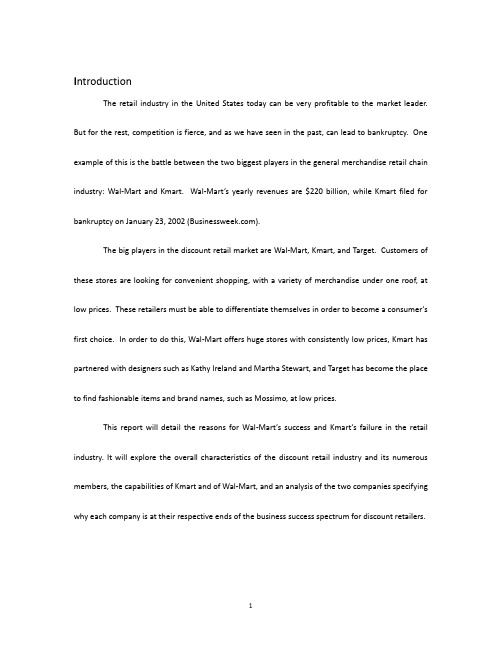
I ntroductionThe retail industry in the United States today can be very profitable to the market leader. But for the rest, competition is fierce, and as we have seen in the past, can lead to bankruptcy. One example of this is the battle between the two biggest players in the general merchandise retail chain industry: Wal-Mart and Kmart. Wal-Mart’s yearly revenues are $220 billion, while Kmart filed for bankruptcy on January 23, 2002 ().The big players in the discount retail market are Wal-Mart, Kmart, and Target. Customers of these stores are looking for convenient shopping, with a variety of merchandise under one roof, at low prices. These retailers must be able to differentiate themselves in order to become a consumer’s first choice. In order to do this, Wal-Mart offers huge stores with consistently low prices, Kmart has partnered with designers such as Kathy Ireland and Martha Stewart, and Target has become the place to find fashionable items and brand names, such as Mossimo, at low prices.This report will detail the reasons for Wal-Mart’s success and Kmart’s failure in the retail industry. It will explore the overall characteristics of the discount retail industry and its numerous members, the capabilities of Kmart and of Wal-Mart, and an analysis of the two companies specifying why each company is at their respective ends of the business success spectrum for discount retailers.目录Walmart,Kmart 发展历史 (2)分析导致2002年Kmart申请破产的具体原因 (5)Walmart 的核心竞争力 (6)Wal-mart具备怎么样的独特资源 (7)Kmart,Walmart,SWOT分析 (8)结论 (9)Walmart 发展历史1950年山姆·沃尔顿开设了第一家特价商店。
沃尔玛的供应链
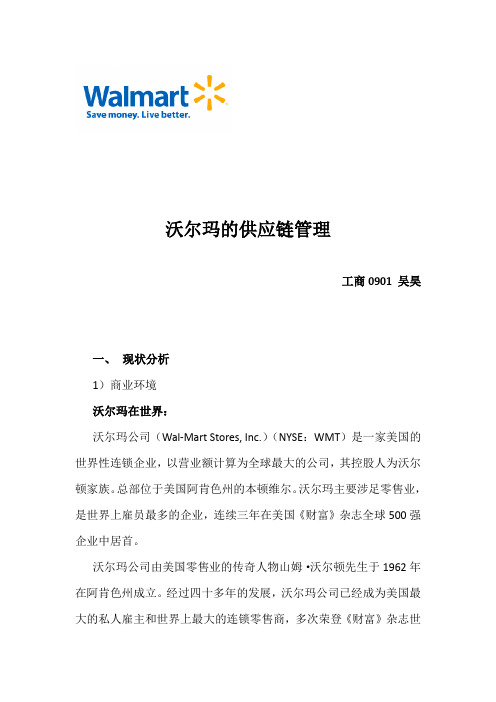
沃尔玛的供应链管理工商0901 吴昊一、现状分析1)商业环境沃尔玛在世界:沃尔玛公司(Wal-Mart Stores, Inc.)(NYSE:WMT)是一家美国的世界性连锁企业,以营业额计算为全球最大的公司,其控股人为沃尔顿家族。
总部位于美国阿肯色州的本顿维尔。
沃尔玛主要涉足零售业,是世界上雇员最多的企业,连续三年在美国《财富》杂志全球500强企业中居首。
沃尔玛公司由美国零售业的传奇人物山姆·沃尔顿先生于1962年在阿肯色州成立。
经过四十多年的发展,沃尔玛公司已经成为美国最大的私人雇主和世界上最大的连锁零售商,多次荣登《财富》杂志世界500强榜首及当选最具价值品牌。
目前,沃尔玛在全球15个国家开设了超过8400家商场,下设55个品牌,员工总数210多万人,每周光临沃尔玛的顾客2亿人次。
2010财政年度(2009年2月1日至2010年1月31日)销售额达4050亿美元,2010财年慈善捐赠资金及物资累计超过5.12亿美元,比09财年增长超过20%。
2010年,沃尔玛公司再次荣登《财富》世界500强榜首,并在《财富》杂志“2010年最受赞赏企业”调查的零售企业中排名第一。
沃尔玛在中国:与在世界其它地方一样,沃尔玛在中国始终坚持“尊重个人、服务顾客、追求卓越”的核心价值观,专注于开好每一家店,服务好每一位顾客,履行公司的核心使命——“帮助顾客省钱,让他们生活得更美好”,以不断地为我们的顾客、会员和员工创造非凡。
2)沃尔玛公司的供应链结构:•集中的配送系统和高效的运输系统•产销一体化•拉动式的供应链模式•完备的信息系统(1)集中的配送系统,和高效的运输系统如果要用图示来概括的话,那么这个系统可以描述为:由上图可以看出来,沃尔玛的所谓集中配送系统实际上是一个顾客、商品供应者、物流、以及商场的供应链的良性循环。
其实,有效的商品配送是保证沃尔玛达到最大销售量和最低成本的存货周转及费用的核心。
据本人对沃尔玛公司的了解,沃尔玛的第一家配送中心于1970年建立,占地6000平方米,负责供货给4个州的32家商场,集中处理公司所销商品的40%。
沃尔玛物流配送体系分析报告

沃尔玛物流配送体系分析报告沃尔玛(Wal—Mart)公司是全世界零售业销售收入位居第一的巨头企业,素以精确掌握市场、快速传递商品和最好的满足客户需求著称,是著名的“全球500强排行”的冠军。
沃尔玛公司是一家美国的世界性连锁企业,以营业额计算为全球最大的公司,其控股人为沃尔顿家族。
总部位于美国阿肯色州的本顿维尔。
沃尔玛主要涉足零售业,是世界上雇员最多的企业,连续三年在美国《财富》杂志全球500强企业中居首。
沃尔玛百货有限公司由美国零售业的传奇人物山姆·沃尔顿先生于1962年在阿肯色州成立。
经过四十多年的发展,沃尔玛公司已经成为美国最大的私人雇主和世界上最大的连锁零售企业。
目前,沃尔玛在全球15个国家开设了超过8,000家商场,下设53个品牌,员工总数210多万人,每周光临沃尔玛的顾客2亿人次。
沃尔玛之所以能够成为世界性的大型零售企业,必然有其成功之道。
经过我们小组的研究,沃尔玛在物流配送体系方面最具有特色,这也是沃尔玛在降低物流配送成本中的一个重要的环节,因而我们小组选择了沃尔玛众多成功因素中的物流配送体系进行分析,期望能够给我国一些的大型零售企业在物流成本的降低方面一些启示。
我们都知道,沃尔玛公司作为全美零售业年销售收入位居第一的著名企业,素以精确掌握市场、快速传递商品和最好地满足客户需要著称,这与沃尔玛拥有自己庞大的物流配送系统并实施了严格有效的物流配送管理制度有关,因为它确保了公司在效率和规模成本方面的最大竞争优势,也保证了公司顺利地扩张。
沃尔玛公司巨大的商品销售数量必然要有一个同样巨大和高效的商品配送系统与之相适应,因为物流配送是实行连锁经营不可缺少的重要组成部分,不发展物流配送,就谈不上真正的连锁经营。
物流配送的水平,在一定程度上体现和决定着整个连锁企业的经营水平。
下面我们小组经过研究,详细介绍沃尔玛现代化的物流配送体系是什么,包含什么内容,以及物流配送体系是如何运作的。
沃尔玛公司首先是设立了运作高效的配送中心。
Walmart
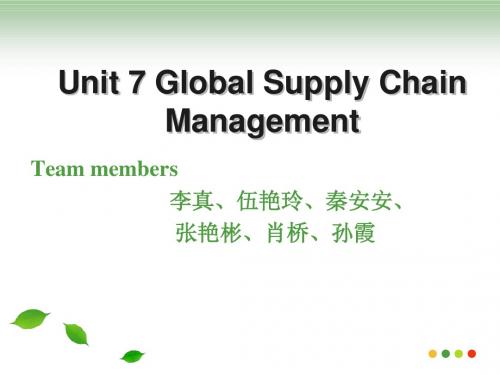
THREE BASIC BELIEFS
• RESPECT FOR THE INDIVIDUAL 尊重个人
• SERVICE Tபைடு நூலகம் OUR CUSTOMER 服务顾客 • STRIVE FOR EXCELLENCE 追求卓越
1 RESPECT FOR THE INDIVIDUAL
• Listening • Accountability • Humility • Trust • Diversity
Unit 7 Global Supply Chain Management
Team members 李真、伍艳玲、秦安安、 张艳彬、肖桥、孙霞
1、Introduction of Walmart 2、Corporate Culture of Walmart 3、Global Supply Chain Management 4、Walmart in China 5、Prospects in the Future 6、Walmart VS Other Retailers
Strengths
• A powerful retail brand • Loyal customers and employee • The use of information technology • H&R management • Good locations • Good benefits for full time • Membership
Good qualities
• Low price • Friendly services • Special labour relations
Three briefs
1. Respect every person
介绍沃尔玛在中国英文作文

介绍沃尔玛在中国英文作文Walmart, a household name globally, has madesignificant strides in China, carving out a niche in the already competitive retail market. Since its entry into the Chinese market in 1996, Walmart has expanded rapidly, becoming a force to reckon with in both urban and rural areas. Its unique blend of affordability, convenience, anda customer-centric approach has enabled it to gain a loyal following among Chinese consumers.One of the key factors that have contributed toWalmart's success in China is its localization strategy.The company has tailored its products and services to cater to the specific needs and preferences of the Chinese market. For instance, Walmart has introduced a wide range of local brands and products, including fresh produce, traditional Chinese medicines, and节日-specific items. Thislocalization strategy has not only resonated with Chinese consumers but has also helped Walmart to differentiateitself from its competitors.Another noteworthy aspect of Walmart's operations in China is its commitment to sustainability. The company hasimplemented several green initiatives, such as energy-efficient lighting and water conservation measures, in its stores. Walmart has also partnered with local suppliers to promote sustainable agriculture and has implementedrecycling programs to reduce waste. These efforts have not only helped Walmart to reduce its environmental footprint but have also aligned it with the Chinese government's push for green development.Walmart's success in China can also be attributed toits robust supply chain management. The company hasinvested heavily in building a robust supply chain infrastructure that ensures the timely delivery of goods to its stores. Walmart has also forged strong partnershipswith local suppliers, enabling it to source qualityproducts efficiently. This supply chain efficiency has allowed Walmart to offer competitive prices and has further cemented its position as a preferred retail destination for Chinese consumers.In addition to its physical stores, Walmart has also made significant investments in digital transformation in China. The company has launched an online shopping platform,allowing customers to shop from their homes. Walmart has also integrated mobile payment options, such as Alipay and WeChat Pay, to cater to the preferences of Chinese consumers. This digital push has not only expandedWalmart's customer base but has also enhanced its brand visibility and market share in China.Despite its success, Walmart faces several challenges in China, including intense competition from localretailers and e-commerce players. To maintain its market leadership, Walmart must continue to innovate and adapt to the rapidly changing retail landscape in China. The company should also focus on leveraging technology and data analytics to improve its operational efficiency, enhance customer experience, and drive sales growth.In conclusion, Walmart's journey in China has been both impressive and challenging. The company's commitment to localization, sustainability, supply chain management, and digital transformation has enabled it to gain a strong foothold in the Chinese market. However, to sustain its growth and leadership position, Walmart must remain agileand responsive to the changing needs and preferences of Chinese consumers.**沃尔玛在中国:零售巨头的征程**沃尔玛,全球家喻户晓的名字,在中国市场上也取得了显著的进步,在竞争激烈的零售市场中开辟了一片天地。
沃尔玛对供应链安全的审核要求

11
Sharing GSV Audit Results 分享GSV审核结果
• Factories which have previously performed GSV audit upon
request of other retailers/clients. 工厂之前已在其他零售商/客户的
Country risks ratings are provided on the next page and are updated every 6 months.国家/地区风险等 级(每六个月进行更新)见下页
8
SCS supplier training
Supply Chain Security 3rd Party Audit Firm 第三方审核机构 Third Party Audit Firms 第三方审核机构 There are approved by Walmart to perform Supply Chain Security audits.以下为沃尔玛认可的、具备供应链安全审核资质的第 三方机构 Intertek (ITS), Bureau Veritas (BV) Omega Compliance, Ltd (Omega) On site Audit Process:现场审核流程
5. Computer System Security
Computer accountability 电脑使用安全责任 Password Protection 密码保护
6. Merchandise Component Suppliers
Contractor Selecting Process 供应商筛选流程 Contractor Security Monitoring 供应商安全监管
沃尔玛WalMart的物流信息系统
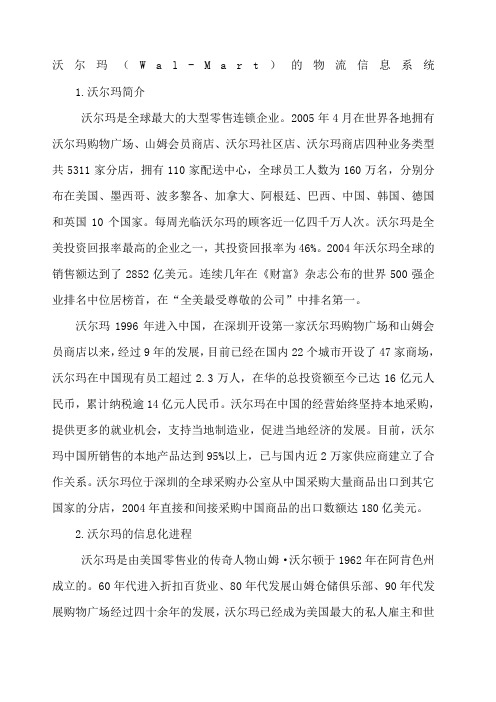
沃尔玛(W a l-M a r t)的物流信息系统 1.沃尔玛简介沃尔玛是全球最大的大型零售连锁企业。
2005年4月在世界各地拥有沃尔玛购物广场、山姆会员商店、沃尔玛社区店、沃尔玛商店四种业务类型共5311家分店,拥有110家配送中心,全球员工人数为160万名,分别分布在美国、墨西哥、波多黎各、加拿大、阿根廷、巴西、中国、韩国、德国和英国10个国家。
每周光临沃尔玛的顾客近一亿四千万人次。
沃尔玛是全美投资回报率最高的企业之一,其投资回报率为46%。
2004年沃尔玛全球的销售额达到了2852亿美元。
连续几年在《财富》杂志公布的世界500强企业排名中位居榜首,在“全美最受尊敬的公司”中排名第一。
沃尔玛1996年进入中国,在深圳开设第一家沃尔玛购物广场和山姆会员商店以来,经过9年的发展,目前已经在国内22个城市开设了47家商场,沃尔玛在中国现有员工超过2.3万人,在华的总投资额至今已达16亿元人民币,累计纳税逾14亿元人民币。
沃尔玛在中国的经营始终坚持本地采购,提供更多的就业机会,支持当地制造业,促进当地经济的发展。
目前,沃尔玛中国所销售的本地产品达到95%以上,已与国内近2万家供应商建立了合作关系。
沃尔玛位于深圳的全球采购办公室从中国采购大量商品出口到其它国家的分店,2004年直接和间接采购中国商品的出口数额达180亿美元。
2.沃尔玛的信息化进程沃尔玛是由美国零售业的传奇人物山姆·沃尔顿于1962年在阿肯色州成立的。
60年代进入折扣百货业、80年代发展山姆仓储俱乐部、90年代发展购物广场经过四十余年的发展,沃尔玛已经成为美国最大的私人雇主和世界上最大的连锁零售商。
沃尔玛的成功与其不断的业态创新、准确的市场定位、先进的配送管理、强大的信息技术支持、“天天平价”的营销策略以及和睦的企业文化等几个因素密不可分。
1970年沃尔玛还不是一个很大的公司,跟信息化、自动化这个概念几乎沾不上边,唯一拥有的处理系统就是底帐和铅笔。
介绍沃尔玛公司总体英语作文
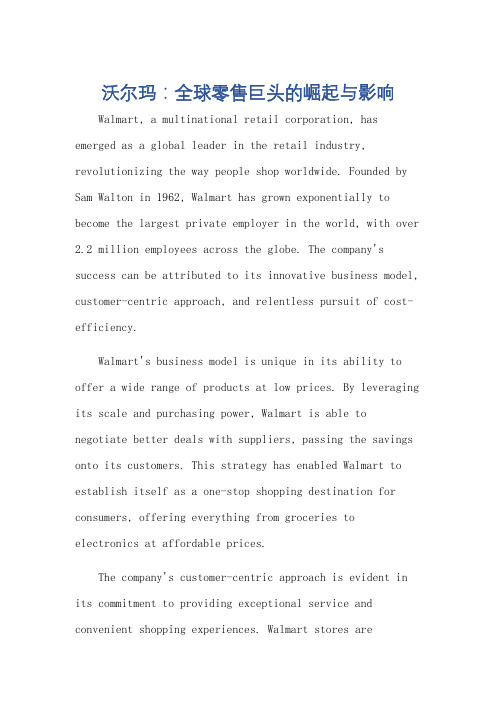
沃尔玛:全球零售巨头的崛起与影响Walmart, a multinational retail corporation, has emerged as a global leader in the retail industry, revolutionizing the way people shop worldwide. Founded by Sam Walton in 1962, Walmart has grown exponentially to become the largest private employer in the world, with over 2.2 million employees across the globe. The company's success can be attributed to its innovative business model, customer-centric approach, and relentless pursuit of cost-efficiency.Walmart's business model is unique in its ability to offer a wide range of products at low prices. By leveraging its scale and purchasing power, Walmart is able to negotiate better deals with suppliers, passing the savings onto its customers. This strategy has enabled Walmart to establish itself as a one-stop shopping destination for consumers, offering everything from groceries toelectronics at affordable prices.The company's customer-centric approach is evident in its commitment to providing exceptional service and convenient shopping experiences. Walmart stores aredesigned to be user-friendly, with clear signage, ample parking, and helpful staff. Additionally, the company has embraced technology to enhance the shopping experience, offering online shopping, mobile apps, and in-store pickup options.Walmart's commitment to cost-efficiency is reflected in its meticulous supply chain management and lean operations. The company has implemented advanced logistics systems to ensure timely delivery of goods to its stores, minimizing inventory costs and wasted resources. Walmart also focuses on sustainable practices, reducing its environmental impact and operating more efficiently.Beyond its financial success, Walmart has had a significant impact on the global economy and society. The company's vast supply chain has created millions of jobsfor suppliers, manufacturers, and distributors, driving economic growth and development in many regions. Walmarthas also been a champion of corporate social responsibility, investing in community development, education, and environmental conservation efforts.However, Walmart's rise to global prominence has not been without controversy. The company has faced criticismfor its impact on small businesses, wage practices, andlabor standards in some of its supply chain locations. These issues have prompted Walmart to reevaluate its business practices and implement changes to addressconcerns and improve its social and environmental footprint. Despite these challenges, Walmart remains a powerful force in the retail industry, shaping the way people shop and businesses operate globally. The company's success is a testament to its innovative business model, customer-centric approach, and commitment to cost-efficiency. As Walmart continues to evolve and adapt to changing market conditions, it remains to be seen how it will continue to shape the future of retail.**沃尔玛:全球零售巨头的崛起与影响**沃尔玛作为一家跨国零售企业,已经在全球零售行业中崭露头角,彻底改变了人们的购物方式。
Walmart沃尔玛成功关键因素分析

02
成功关键因素一:高效的 供应链管理
供应商管理
供应商选择
沃尔玛在选择供应商时,注重质 量、价格和交货期等多方面因素, 确保供应商能够提供优质、稳定、 价格合理的产品。
供应商合作
与供应商建立长期合作关系,通 过信息共享、协同计划和预测等 手段,实现供应链的紧密合作和 高效运作。
供应商评价与激励
定期对供应商进行评价,根据评 价结果进行激励或改进,促进供 应商持续改进和提高供应质量。
公司总部位于美国阿肯色州的 本顿维尔,是全球最大的零售 商之一。
沃尔玛在全球27个国家拥有超 过11000家门店,员工总数超 过220万人。
公司发展历程
1
1962年,沃尔玛第一家折扣店在阿肯色州开业。
2
1970年,沃尔玛成为上市公司。
3
1983年,第一家山姆会员店在美国俄克拉荷马州 开业。
公司发展历程
05
成功关键因素四:技术创 新与应用
电子商务平台
电子商务平台
沃尔玛拥有强大的电子商务平台,能够提供 便捷的在线购物体验,满足消费者对于便利 性的需求。
扩展全球业务
通过电子商务平台,沃尔玛成功地扩展了全球业务 ,进入了新的市场,提高了销售额和市场份额。
提升品牌形象
电子商务平台有助于提升沃尔玛的品牌形象 ,使其成为一家技术先进、服务优质的零售 商。
库存控制与调整
通过实时库存监控和调整措施,确保库存水平与实际需求保持一致, 降低库存风险。
库存盘点与优化
定期进行库存盘点,发现并解决库存问题,持续优化库存结构和管理 水平。
03
成功关键因素二:低成本、 高效率的经营模式
采购策略
全球采购
沃尔玛采用全球采购策略,利用规模优势降低采购成本,并从世 界各地获取优质产品。
Wal-Mart's Supply Chain
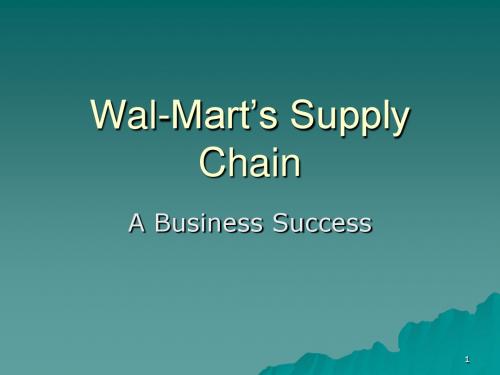
20
CrossCross-docking
The system reduced the handling and storage of finished goods, virtually eliminating the role of the distribution centers and stores. The manufacturer directly forwarded the goods to a place called the “staging area.” The goods were packed here according to the orders received from different stores and then directly sent to the respective customers.
18
Logistics Management… Management…
WalWal-Mart believed that it needed drivers who were committed and dedicated to customer service. The company hired only experienced drivers who had driven more than 300,000 accident-free miles, with no accidentmajor traffic violation.
19
CrossCross-docking
To make its distribution process more efficient, Wal-Mart also made use of a Wallogistics technique called “cross-docking.” “crossIn this system, the finished goods were directly picked up from the manufacturing plant, sorted out and then directly supplied to the customers.
沃尔玛的供应链管理模式

沃尔玛的供应链管理模式沃尔玛(Walmart)是全球最大的零售商之一,以其高效的供应链管理模式而闻名于世。
沃尔玛的供应链管理模式以低成本、高效率和高质量为核心,有效地提供了大量商品以满足全球消费者的需求。
本文将深入探讨沃尔玛供应链管理模式的特点和优势。
一、零售巨头的供应链管理沃尔玛的供应链管理模式是其长期成功的基石,为公司建立了巨大的竞争优势。
该模式在供应链的每个环节都遵循着严格的标准和流程,以确保产品从供应商到最终消费者之间的无缝协调和高效运作。
以下是沃尔玛供应链管理模式的重要特点:1. 真正的合作伙伴关系:沃尔玛与供应商建立了长期的合作伙伴关系,共同面对市场挑战和追求共同利益。
双方通过共享信息、资源和技术,实现供应链的优化和协调。
2. 高度的供应链透明度:沃尔玛实施了先进的信息技术系统,实现供应链的全程透明度。
供应商可以及时获得销售数据、库存情况和市场需求等信息,以便灵活调整生产和配送计划。
3. 低成本原则:沃尔玛在供应链的每个环节都强调降低成本。
通过与供应商共同优化采购、运输和仓储等环节,沃尔玛实现了规模效应和经济效益的最大化。
4. 大规模仓储和物流网络:沃尔玛拥有庞大的仓储和物流网络,使得产品能够快速准确地从供应商运送到各个销售点。
这种高效的物流系统确保了产品的及时到达和货架的供应。
二、沃尔玛供应链管理模式的优势沃尔玛供应链管理模式的优势不仅体现在企业内部的运作效率上,同时也为消费者、供应商和整个市场带来了巨大的益处。
以下是沃尔玛供应链管理模式的主要优势:1. 降低成本、提高效率:沃尔玛供应链管理模式的核心目标是以最低的成本提供高质量的产品和服务。
通过精确的需求预测、优化的采购和库存管理,沃尔玛实现了供应链的高效运作,降低了运营成本和库存风险。
2. 加速商品流通:沃尔玛的供应链管理模式能够实现商品的快速流通和及时上架。
通过准确的需求预测和协调的物流安排,沃尔玛能够更好地满足消费者需求,提高销售额和市场份额。
沃尔玛的供应链安全
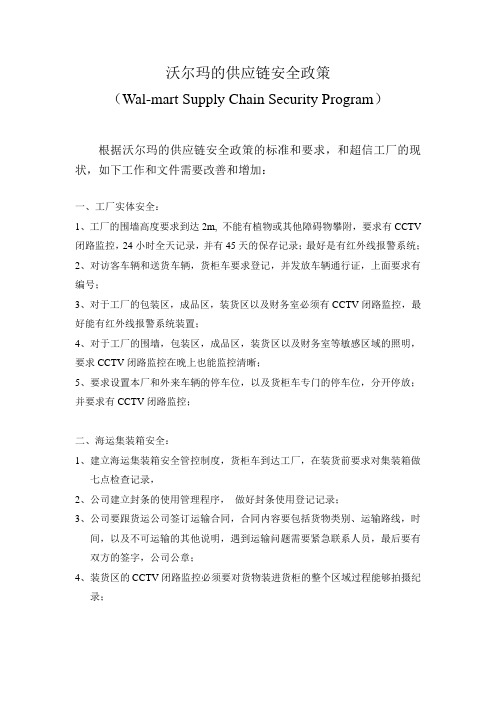
沃尔玛的供应链安全政策(Wal-mart Supply Chain Security Program)根据沃尔玛的供应链安全政策的标准和要求,和超信工厂的现状,如下工作和文件需要改善和增加:一、工厂实体安全:1、工厂的围墙高度要求到达2m, 不能有植物或其他障碍物攀附,要求有CCTV 闭路监控,24小时全天记录,并有45天的保存记录;最好是有红外线报警系统;2、对访客车辆和送货车辆,货柜车要求登记,并发放车辆通行证,上面要求有编号;3、对于工厂的包装区,成品区,装货区以及财务室必须有CCTV闭路监控,最好能有红外线报警系统装置;4、对于工厂的围墙,包装区,成品区,装货区以及财务室等敏感区域的照明,要求CCTV闭路监控在晚上也能监控清晰;5、要求设置本厂和外来车辆的停车位,以及货柜车专门的停车位,分开停放;并要求有CCTV闭路监控;二、海运集装箱安全:1、建立海运集装箱安全管控制度,货柜车到达工厂,在装货前要求对集装箱做七点检查记录,2、公司建立封条的使用管理程序,做好封条使用登记记录;3、公司要跟货运公司签订运输合同,合同内容要包括货物类别、运输路线,时间,以及不可运输的其他说明,遇到运输问题需要紧急联系人员,最后要有双方的签字,公司公章;4、装货区的CCTV闭路监控必须要对货物装进货柜的整个区域过程能够拍摄纪录;三、受限区域安全:1、包装,成品仓,装货区都为工厂的受限区域,要求都要安装CCTV闭路监控,做24小时全天记录;2、包装,成品仓,装货区的工作人员要有厂牌或袖章区分辨别,成品仓和装货区要求授权人员名单,并对授权人员每三个月做一次定期的背景调查,要求粘贴“未授权人员不可进入”的告示,同时要求做好非授权人员的进出入记录;3、包装区要求有专门的员工私人物品存放区,不可将私人物品直接带入受限的包装区域;四、电脑信息安全:1、指定特定人员为电脑信息安全管理员,设定为授权管理员;2、做好电脑账户和密码管理,要求有2个月电脑做一次电脑密码更换;电脑可以设定输入三次密码,电脑将自动关闭使用,做好相关的记录;有可能的黑客侵入记录;五、人员安全:1、新员工的背景调查,要求包括工作经历,身份证、学历、现住址,以及确认有无犯罪吸毒行为,做好相关的文件记录和证明文件;(记录内容要求:基本信息,时间,调查方式(电话或网络,联系人),调查结果,调查人);2、建立新员工的反恐培训程序,做好培训记录;3、建立在职员工定期的反恐培训程序,做好相关的培训记录;4、建立员工离职程序文件,并向员工通告解释说明,做好员工离职物品回收清单记录;超信金属有限公司2012年8月17日。
沃尔玛企业分析报告

沃尔玛企业分析报告1. 概况沃尔玛(Wal-Mart)是一家全球领先的零售企业,总部位于美国阿肯色州。
自1962年首家门店开业以来,沃尔玛已迅速发展成为全球最大的零售商之一,拥有超过11,000家门店遍布世界各地。
沃尔玛的商业模式主要基于提供高质量低价的商品和服务,致力于为消费者创造更便宜、更方便的购物体验。
2. 产业链分析沃尔玛的产业链主要包括供应链、零售门店和电子商务部门。
供应链是沃尔玛成功的关键因素之一,通过与供应商建立长期合作关系,并且采取高效的物流管理,沃尔玛能够获得更低的采购成本和更高的库存周转率。
在全球贸易不断增加的背景下,沃尔玛通过在全球范围内采购商品,进一步降低成本并提供更多选择。
沃尔玛的零售门店是其主要的销售渠道,门店遍布世界各地,以低价和高质量的商品吸引了大量消费者。
沃尔玛门店以超市和大型商场为主,提供从食品、日用品到家电、家具等丰富的商品选择。
随着电子商务的快速发展,沃尔玛也积极发展线上业务。
通过沃尔玛的官方网站和移动应用程序,消费者可以随时随地购买商品,并享受到灵活的配送服务。
沃尔玛还与其他电商平台合作,扩大其在线销售渠道。
3. SWOT分析3.1 优势沃尔玛具有以下几个明显的优势:- 规模经济效益:沃尔玛拥有庞大的门店网络和供应链系统,能够以大规模获得更低的采购成本,并通过高库存周转率提高利润率。
- 品牌知名度和信誉:沃尔玛作为全球零售业的领军企业,其品牌知名度和信誉在消费者中非常高。
- 全球化运营:沃尔玛在多个国家和地区都有门店,并且具备深入了解各地消费者需求的能力。
3.2 劣势沃尔玛也存在一些劣势:- 激烈的竞争:沃尔玛作为零售行业的巨头,面临着来自其他零售商和电商的激烈竞争,需要不断努力保持市场地位。
- 技术和数字化转型:沃尔玛在电子商务和数字化方面的投资相对较晚,需要加快技术升级和转型,以满足消费者日益增长的在线购物需求。
3.3 机会沃尔玛面临以下机会:- 中国市场的增长:中国是全球最大的消费市场之一,沃尔玛可以继续扩大在中国的业务,并与国内企业合作。
2012-8-21 Wal-Mart SCS audit Training training chinese

*Notes: International market program will start from end of March. The dates for each market’s roll out will be published separately. 针对国际市场的供应链安全项目将自三月底开始执行,各个市场的具体执行 日期将分别公布
2011
Walmart Supply Chain Security Program
“Committed to ensuring safe global commerce”
Global Sourcing Asset Protection and Security
About Supply Chain Security 供应链安全审核 Supply Chain Security covers different areas including: 1. Factory Facility Security 工厂实体安全 Physical access control 厂房进出的控制 Perimeter fencing / wall 四周的围栏/围墙 Gates & gate houses 大门和大门值班室 Parking 停车位 Building structure 大楼建筑结构 Locking devices & Key controls 门锁及钥匙的管控 Lighting 照明 Alarms systems & video surveillance cameras 报警系统
工厂大门门卫对出厂卡车进行检查, 验证记录、货柜及拖车号, 并核对出货记录及封条号
11
SCS supplier training
沃尔玛:沃尔玛供应链安全计划

About Supply Chain Security 供应链安全审核
Supply Chain Security covers different areas including:
1. Factory Facility Security 工厂实体安全 ➢ Physical access control 厂房进出的控制 ➢ Perimeter fencing / wall 四周的围栏/围墙 ➢Gates & gate houses 大门和大门值班室 ➢Parking 停车位 ➢Building structure 大楼建筑结构 ➢Locking devices & Key controls 门锁及钥匙的管控 ➢Lighting 照明 ➢Alarms systems & video surveillance cameras 报警系统
6 SCS supplier training
New factory -- Pre-qualification Process 新工厂预审步骤
• New factory
– May receive a Factory ID supplier can submit a product offer, before factory become active with all ES, FCCA and SCS satisfied 新工厂将会收到一个工厂ID供应商可以递交产品报价,
*Notes: International market program will start from end of March. The dates for each market’s roll out will be published separately.
Wal-mart
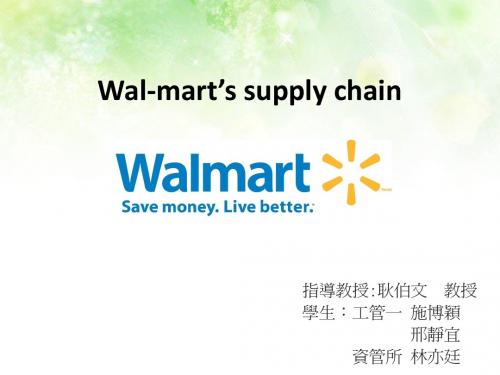
公司簡介(Cont’d)
1962 1987 1990 1991 2000 2005 2008 2009 2011
山 姆 ‧ 沃 爾 瑪 創 立 於 阿 肯 色 州
沃規 爾模 瑪最 完大 成的 衛私 星有 網通 路訊 ,衛 擁星 有系 美統 國。
沃 爾 瑪 成 為 全 美 第 一 大 零 售 企 業 。
只在貨架和大型的貨箱上使用,還沒用到單品, 不過這一定是未來潮流。
Wal-Mart RFID體系效益
RFID可使全球零售業降低人工成本40~50%,庫存 量降低10~30%。 獲利將提升38%,而其生產力比同業高出40%。
導入RFID技術後,對缺貨率改善約30%、補貨速度 提高3倍、門市平均庫存降低10%。
供應鏈管理(Cont’d)
存貨管理-連續供貨、不斷貨:
存貨通常佔公司30%的成本,高科技的應用,使配送物 品不超過48小時,大大節省了存貨成本。
迅捷的運輸系統:
配送中心內85%都採用機械處理,減少人工處理商品的 費用,銷售成本低於同業平均銷售成本2%~3%。 從倉庫到任何商店的進貨時間:分店貨架平均每 周補貨兩次v.s.平均每兩周補貨一次 (其他零售業)。
Thanks for your listening
良好的顧客關係管理(CRM)
•
顧客導向的價值管理
– – – –
遵循顧客的要求 產品選擇—大量而多樣,讓顧客一次購足 價格與品牌 關係與經驗—掌握每一接觸經驗建立互動關係
•
顧客導向與利潤導向的連結
–
將創造價值視為企業的基本任務,而非創造利潤
無線射頻辨識系統(RFID)
取代條碼,條碼的缺點是必須一個個掃描,會掉 會有污損。 貨架貨箱無論處於供應鏈中的哪個階段就都可以 追蹤。
wal-mart
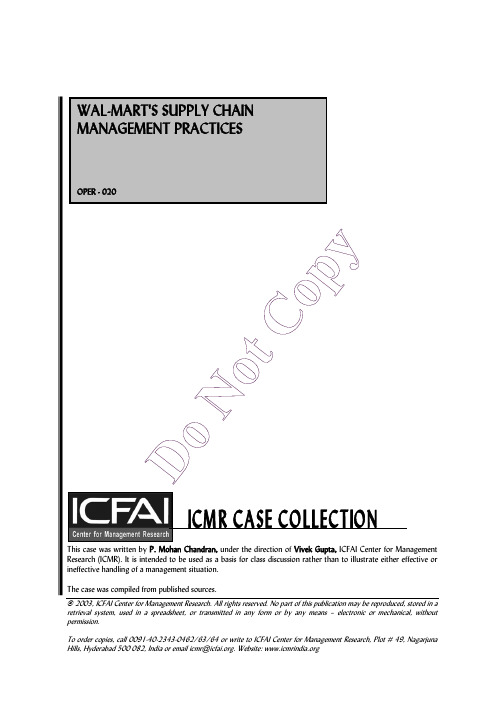
INTRODUCTION
The US-based Wal-Mart ranked first in the global Fortune 500 list in the financial year 2001-02 earning revenues of $219.81 billion (Refer Table I). Wal-Mart was the largest retailing company in the world. The company was much bigger than its competitors in the US – Sears Roebuck, KMart, JC Penney and Nordstrom combined (Refer Exhibit I). In 2002, Wal-Mart operated more than 3,500 discount stores, Sam’s Clubs and Supercenters in the US and more than 1,170 stores in all major countries across the world. The company also sold products on the Internet through its website, .
GLOBAL FORTUNE 500 LIST (2002)
Source:
Wal-Mart was one of the largest private sector employers in the world, with employee strength of approximately 1.28 million. The company’s founder, Sam Walton (Walton) had always focused on improving sales, constantly reducing costs, adopting efficient distribution and logistics management systems and using innovative information technology (IT) tools. According to analysts, Wal-Mart was able to achieve a leadership status ((Refer Exhibit II)) in the retail industry because of its efficient supply chain management practices. Captain Vernon L. Beatty, aide-de-camp to the commander, Defense Supply Center, Columbus, Ohio said, “Supply chain management is moving the right items to the right customer at the right time by the most efficient means. No one does that better than Wal-Mart.”
沃尔玛的全面风险管理战略(英文版)
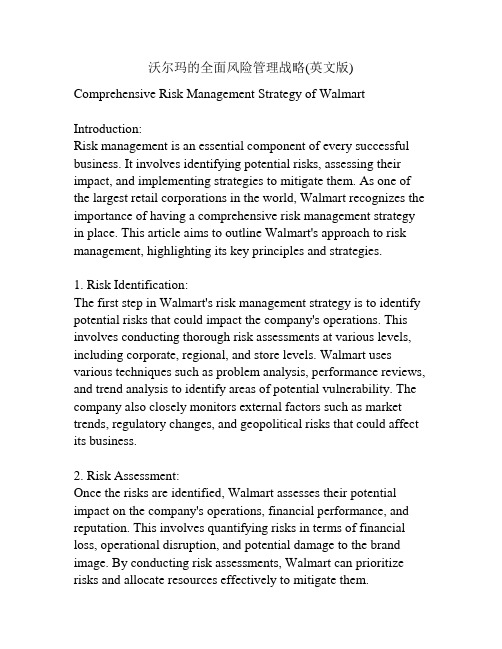
沃尔玛的全面风险管理战略(英文版) Comprehensive Risk Management Strategy of Walmart Introduction:Risk management is an essential component of every successful business. It involves identifying potential risks, assessing their impact, and implementing strategies to mitigate them. As one of the largest retail corporations in the world, Walmart recognizes the importance of having a comprehensive risk management strategy in place. This article aims to outline Walmart's approach to risk management, highlighting its key principles and strategies.1. Risk Identification:The first step in Walmart's risk management strategy is to identify potential risks that could impact the company's operations. This involves conducting thorough risk assessments at various levels, including corporate, regional, and store levels. Walmart uses various techniques such as problem analysis, performance reviews, and trend analysis to identify areas of potential vulnerability. The company also closely monitors external factors such as market trends, regulatory changes, and geopolitical risks that could affect its business.2. Risk Assessment:Once the risks are identified, Walmart assesses their potential impact on the company's operations, financial performance, and reputation. This involves quantifying risks in terms of financial loss, operational disruption, and potential damage to the brand image. By conducting risk assessments, Walmart can prioritize risks and allocate resources effectively to mitigate them.3. Risk Mitigation Strategies:After assessing the risks, Walmart implements strategies to mitigate them and minimize their impact on the company. This includes developing and implementing robust internal controls, standard operating procedures, and policies to prevent and detect risks. Walmart also invests in state-of-the-art technology and infrastructure to ensure the security and efficiency of its operations. For example, the company uses advanced surveillance systems and cybersecurity measures to protect its stores and customer data from potential threats.Walmart also believes in fostering a culture of risk management throughout the organization. It educates and trains its employees on risk awareness and encourages them to report any potential risks or violations. This helps Walmart to proactively address risks and prevent potential issues before they escalate.4. Crisis Management:Despite careful planning and risk mitigation efforts, unexpected events can still occur. Walmart understands the importance of having a robust crisis management plan in place. The company has a dedicated crisis management team that is responsible for coordinating responses to various crises, such as natural disasters, product recalls, or public relations crises. Walmart's crisis management plan outlines clear procedures for communication, decision-making, and business continuity to ensure a swift and effective response to any crisis situation.5. Business Continuity Planning:Another critical aspect of Walmart's risk management strategy is business continuity planning. This involves developing strategies and procedures to ensure the continuous operation of key business functions in the event of a disruption. Walmart has comprehensive business continuity plans at both the corporate and individual store levels. These plans outline alternative operating procedures, backup systems, and recovery strategies to minimize downtime and mitigate the impact of any disruption.6. Continuous Improvement:Walmart recognizes that risk management is an ongoing process that requires continuous improvement and adaptation. The company regularly reviews and updates its risk management strategies to address emerging risks and changing business environments. It actively seeks feedback from employees, customers, and stakeholders to identify areas for improvement and implement necessary changes.Conclusion:Walmart's comprehensive risk management strategy demonstrates its commitment to ensuring the safety, security, and continuity of its operations. By adopting a proactive and holistic approach torisk management, Walmart can identify and mitigate potential risks, minimize their impact, and maintain its position as one of the world's leading retail corporations.Certainly! Here are some additional points to expand on Walmart's risk management strategy: 1. Supply Chain Risk Management:Walmart's risk management strategy includes a strong focus on supply chain management. The company recognizes thatdisruptions in its supply chain can have a significant impact on its operations and ability to serve customers. To mitigate supply chain risks, Walmart has implemented several strategies. Firstly, the company has diversified its supplier base to reduce dependency on a single supplier or region. This helps to minimize the impact of any potential disruptions, such as natural disasters or geopolitical issues. Secondly, Walmart closely collaborates with its suppliers to ensure they meet specific quality, safety, and compliance standards. The company also conducts regular audits and inspections to mitigate the risks associated with unethical practices or non-compliance.2. International Risk Management:As a global retail corporation, Walmart operates in various countries with different regulatory, political, and cultural environments. To manage the risks associated with international operations, Walmart has established a robust governance structure. The company has a dedicated international risk management team that monitors and assesses risks specific to each country. This allows Walmart to tailor its risk mitigation strategies to address the unique challenges and requirements of individual markets. Additionally, Walmart maintains strong relationships with local stakeholders, government agencies, and industry associations to proactively address any potential risks or issues that may arise.3. Data Privacy and Cybersecurity:The increasing reliance on technology and digital systems within the retail industry brings new risks such as data breaches and cyber-attacks. Walmart recognizes the importance of protecting customer and company data from potential threats. The companyhas invested heavily in cybersecurity measures, including firewalls, encryption, and constant monitoring of its systems. Walmart also regularly conducts vulnerability assessments and penetration tests to identify and address any potential weaknesses. In addition to technical safeguards, Walmart has implemented strict data privacy policies and procedures to ensure compliance with relevant regulations and protect customer privacy.4. Regulatory Compliance:Operating in a highly regulated industry, Walmart places a strong emphasis on compliance with applicable laws and regulations. The company has a dedicated legal and compliance team that monitors and ensures adherence to local, national, and international regulations. Walmart invests in training programs for its employees to ensure they are aware of and comply with relevant laws and regulations. The company also conducts regular internal audits to assess compliance and identify areas for improvement. Walmart's commitment to regulatory compliance helps to mitigate the risks associated with legal sanctions, reputational damage, and operational disruptions.5. Environmental Sustainability:Walmart recognizes the risks associated with climate change and environmental degradation and has integrated sustainable practices into its risk management strategy. The company has set ambitious goals to reduce greenhouse gas emissions, promote renewable energy, minimize waste, and conserve natural resources. By adopting sustainable business practices, Walmart reduces its exposure to potential regulatory, reputational, and operational risks. The company also works closely with its suppliers to promotesustainable sourcing and production practices throughout its supply chain.Conclusion:Walmart's comprehensive risk management strategy encompasses a wide range of areas, including risk identification, assessment, mitigation, crisis management, business continuity planning, and continuous improvement. Through its proactive and holistic approach, Walmart can effectively manage potential risks and ensure the safety, security, and continuity of its operations. By placing a strong emphasis on supply chain integrity, international risk management, data privacy, regulatory compliance, and environmental sustainability, Walmart demonstrates its commitment to long-term success and resilience in an ever-changing business landscape.。
沃尔玛供应链分析
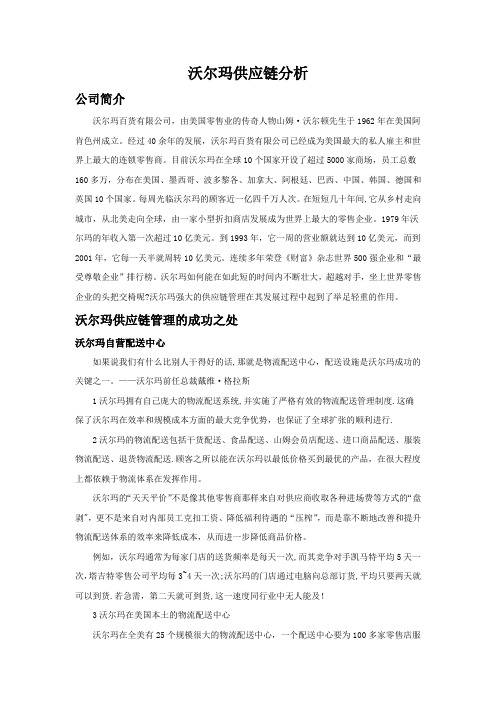
沃尔玛供应链分析公司简介沃尔玛百货有限公司,由美国零售业的传奇人物山姆·沃尔顿先生于1962年在美国阿肯色州成立。
经过40余年的发展,沃尔玛百货有限公司已经成为美国最大的私人雇主和世界上最大的连锁零售商。
目前沃尔玛在全球10个国家开设了超过5000家商场,员工总数160多万,分布在美国、墨西哥、波多黎各、加拿大、阿根廷、巴西、中国、韩国、德国和英国10个国家。
每周光临沃尔玛的顾客近一亿四千万人次。
在短短几十年间,它从乡村走向城市,从北美走向全球,由一家小型折扣商店发展成为世界上最大的零售企业。
1979年沃尔玛的年收入第一次超过10亿美元。
到1993年,它一周的营业额就达到10亿美元,而到2001年,它每一天半就周转10亿美元。
连续多年荣登《财富》杂志世界500强企业和“最受尊敬企业”排行榜。
沃尔玛如何能在如此短的时间内不断壮大,超越对手,坐上世界零售企业的头把交椅呢?沃尔玛强大的供应链管理在其发展过程中起到了举足轻重的作用。
沃尔玛供应链管理的成功之处沃尔玛自营配送中心如果说我们有什么比别人干得好的话,那就是物流配送中心,配送设施是沃尔玛成功的关键之一。
——沃尔玛前任总裁戴维·格拉斯1沃尔玛拥有自己庞大的物流配送系统,并实施了严格有效的物流配送管理制度.这确保了沃尔玛在效率和规模成本方面的最大竞争优势,也保证了全球扩张的顺利进行.2沃尔玛的物流配送包括干货配送、食品配送、山姆会员店配送、进口商品配送、服装物流配送、退货物流配送.顾客之所以能在沃尔玛以最低价格买到最优的产品,在很大程度上都依赖于物流体系在发挥作用。
沃尔玛的“天天平价”不是像其他零售商那样来自对供应商收取各种进场费等方式的“盘剥",更不是来自对内部员工克扣工资、降低福利待遇的“压榨”,而是靠不断地改善和提升物流配送体系的效率来降低成本,从而进一步降低商品价格。
例如,沃尔玛通常为每家门店的送货频率是每天一次,而其竞争对手凯马特平均5天一次,塔吉特零售公司平均每3~4天一次;沃尔玛的门店通过电脑向总部订货,平均只要两天就可以到货.若急需,第二天就可到货,这一速度同行业中无人能及!3沃尔玛在美国本土的物流配送中心沃尔玛在全美有25个规模很大的物流配送中心,一个配送中心要为100多家零售店服务,日处理量为20多万箱。
- 1、下载文档前请自行甄别文档内容的完整性,平台不提供额外的编辑、内容补充、找答案等附加服务。
- 2、"仅部分预览"的文档,不可在线预览部分如存在完整性等问题,可反馈申请退款(可完整预览的文档不适用该条件!)。
- 3、如文档侵犯您的权益,请联系客服反馈,我们会尽快为您处理(人工客服工作时间:9:00-18:30)。
Stores are run as independent businesses and will do everything to satisfy their local customers
Key processes
• Suppliers linked to company
extranet – Direct delivery of SKUs to POS – High availability ratio to minimize lost sales
• EDI with suppliers
PIT_ZXI493_032901_DD_v1
WAL*MART – BACKGROUND
Business overview
• America’s largest retailer serving customers primarily through the
operation of – Wal-mart stores (discount department stores) – Sam’s Clubs (warehouse membership clubs) – Wal-mart Supercenters • Sales of nearly $191 billion in the fiscal year ending Jan. 31, 2001 • Employs more than 1 million associates worldwide through nearly 3,500 facilities in the United States and more than 1,000 units in Mexico, Puerto Rico, Canada, Argentina, Brazil, China, Korea, Germany and the United Kingdom Business technology agenda
• Using IT to reduce supply chain costs and improve operations efficiency • Using IT to enable Wal*mart to deliver its promise of everyday low prices
Source: Annual reports
•
•
– Lower inventory cost – Reduced lead time POS data sharing with suppliers – Visibility of demand and inventory levels to suppliers Procurement through private exchanges – Quick response – Reduced cost of procurement
• Started leveraging technology as
early as 1983
• Stopped sharing POS data
Marketing business system Product Margin mix mgmt. Channel mgmt. Advertising and branding Customer service/ relation -ship
Sales
Support business system Accounts payable/ receivable MRO management (indirect goods) Human resources
payments, check authorization and refunds Be selective in the connections you make and in the information you provide to others to ensure you capture value Select appropriate solutions and create the right balance between custom solutions and “off-theshelf” packages
Distribution/ Logistics
Retail/ Store format
Selling
Stores clustered Every day low around DC’s pricing
Emphasis on high frequency items
Centralized buying with regional tailoring
… so they focused on
• Driving costs out of
the system • Highly efficient supply chain
Source: Literature search; press releases; HBS case “Wal*Mart Stores Inc.”; McKinsey analysis
Order mgmt.
• Fast management of cash
flow through electronic networks
Source: McKinsey analysis
4
PIT_ZXI493_032901_DD_v1
… AND APPLIED TECHNOLOGY TO DRIVE COMPETITIVE ADVANTAGE
Operations business system Research and development Input costs mgmt. Supply chain mgmt. Manufacturing/ service provision -ing Fulfillment
Key processes
Source: McKinsey analysis
2
PIT_ZXI493_032901_DD_v1
WAL*MART’S IT-ENABLED COMPETITIVE ADVANTAGE
Sam Walton opened his first Wal*Mart store in Rogers, Arkansas in 1962… • Had an early focus on being distinctive in its offerings • Hub and spoke network design • Few touch points in the distribution system … and started leveraging technology as early as 1983…
3
PIT_ZXI493_032901_DD_v1
WAL*MART FOCUSED ON LEVERAGE POINTS…
Operations business system Research and development Input costs mgmt. Supply chain management Manufacturing/ service provision -ing Fulfillment
• Electronic scanning of Uniform Product Codes (UPC) at
the Point of Sale (POS) began and was completed for all stores by 1988, 2 years ahead of Kmart • Introduced electronic tracking of refunds and check authorization • Satellite installed at head office in Bentonville, AK in 1983 They continued to seamlessly integrate with the suppliers… • Beginning in 1990, “retail-link” gave more than 2,000 suppliers computer access to point of sale data
• Company extranet • POS data visibility to suppliers
• Electronic scanning of • •
POS data Satellite communication EDI “retail link”
Support business system Accounts payable/ receivable MRO mgmt. (indirect goods) Human resources
Order mgmt.
• Electronic invoicing,
Implications
Although initial steps can be taken quickly and value can be created in the near-term, the path to competitive advantage is a multi-year journey
Force vendors to DSD (directstore-delivery)
No inventory at stores, vendors responsible to use, sit or hold extra stock
Pricing/ merchandising decisions decentralized to store managers to tailor to local needs
